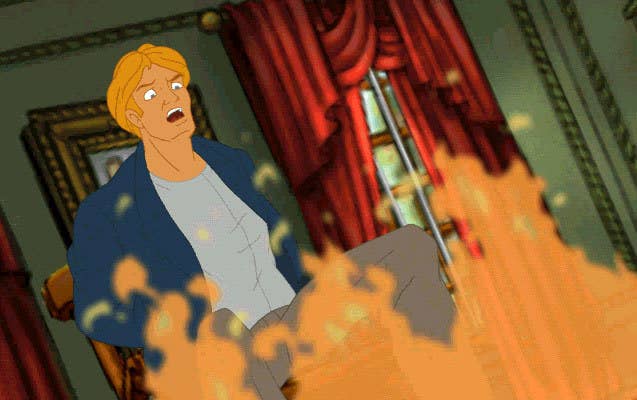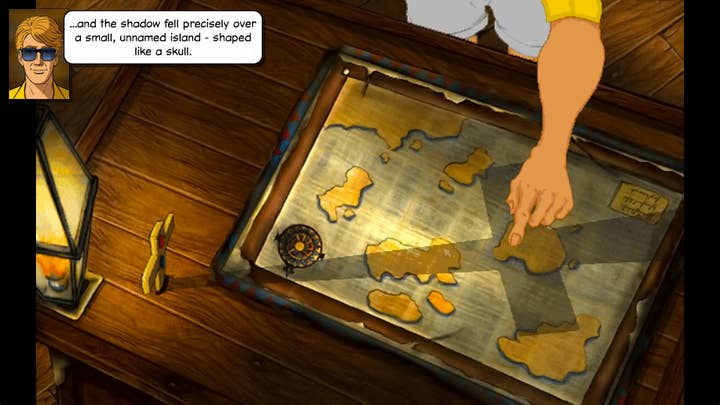The magic of discovery in Broken Sword | Why I Love
Tag of Joy co-founders Šarūnas and Žilvinas Ledas talk about Charles Cecil's seminal adventure series
Why I Love is a series of guest editorials on GamesIndustry.biz intended to showcase the ways in which game developers appreciate each other's work. This entry was contributed by Šarūnas and Žilvinas Ledas, co-founders of Tag of Joy, the developer of the hand-painted adventure Crowns and Pawns: Kingdom of Deceit, published by Thunderful Games and launching on PC May 6.
A beautiful, innovative, fulfilling, challenging, satisfying, mysterious game. Not only a game, but a story, an experience. It got a lot of components right and was one of the best games back then and it still is. It's worth saying that the series is still very much alive, as the fifth instalment was released in 2014 and there are rumours of (and a lot of fans craving for) the sixth game. Yes, you may have guessed it (or read in the title) - we are talking about Broken Sword: The Shadow of the Templars. But let's talk about why such an opinion would form in the first place.
My brother and I started playing PC games right before 2000 and very quickly got drawn into the world of adventures. Of course, we had played NES games like Super Mario, Battle City and Adventure Island. However, adventure games were something else: they had a story, they had amazing art, voice acting, beautiful animation and music.
One of us got our hands on a demo of Broken Sword 2: The Smoking Mirror and couldn't stop talking about it. Our screen time was limited and it was summer, so we spent a lot of time outside and out of town, but the demo left such a big impression on a teenage brain that a lot of that time was spent analysing the puzzles, animation, story and other aspects of that amazing demo (no wonder demos had a revival in the last decade -- it's a very good way to attract players to buy the full game!).

Soon after, we got the full game and started playing it together. Well, not exactly together - we would play in turns, and it became a competition about who would solve a puzzle first. But during the off-screen time we would actually collaborate in figuring out how to move forward. The adventure traversed into the real world -- we travelled to the Caribbean and to a Mayan temple in our heads, trying to outrun the bad guys (and each other, haha). It was epic.
Broken Sword 2 was the first adventure game we played and it was great, but it's actually not the one we're talking about here today. A little later we got our hands on Broken Sword: The Shadow of the Templars, which is the first Broken Sword game. You would expect nostalgia to tell you that the first game you played is better, but we (semi-)objectively believe the first instalment did at least one thing better, which I only realised much later and will come back to.
All games in the series had a story that could've been called innovative back in the day. You go to real places, you look for historical facts, you find quasi-real artefacts. Of course, they have some magical or at least mystical powers, because if they didn't, bad people wouldn't be after them!
Nowadays, everyone's aware of stories like The Da Vinci Code, but Broken Sword was one of the first (if not the first) to explore this kind of narrative that involves real facts, locations and mixes them with fiction, mystery and a bit of fantasy, and did it super well. The plot is based on Charles Cecil's research on the Knights Templar and tells us about a mysterious Neo-Templar organisation that wants to acquire the powers of a historical relic.
It's actually pretty hard to write a story like that, something we learned just recently while working on our own story in Crowns and Pawns: Kingdom of Deceit. It requires a lot of research, fact checking, location scouting, trying to figure out the correct (or at least convincing) sequence of historical events -- and on top of that, you want to add some fiction that would spice things up and distinguish the game from a history book. That fiction has to seem realistic enough to fit in the real-world setting, though. The puzzles can't be crazy too; they need to use real world objects and at least have a good explanation (either through words or context) of why a certain obstacle is there. So, it's a pretty big challenge, which the Broken Sword series tackles really well.

Broken Sword: The Shadow of the Templars was also innovative in using high-end animation. The cinematic sequences were animated by feature film animators and in-game scenes took a leap forward by using different camera angles. Games before that had usually used flat-perspective backgrounds, where the camera is on the side of the room, always at a similar height. And that makes sense, because 2D animated characters couldn't change perspective that easily, so you would always be limited to a similar angle, otherwise characters would pop out. Whereas Broken Sword went an extra mile and not only mixed the angles in that acceptable range more than others, but also had the balls to make custom animation clips, just to have a few completely different looking scenes. There aren't a lot of areas like that, but those few had a huge impact on the impression of the game.
These are very well delivered components of the game(s), but years later, when trying to figure out what aspect left the biggest impression and why the first game felt better than the second one in the series, one realisation materialised. There's this special feeling that Broken Sword: The Shadow of the Templars manages to convey: when you enter a new area, within a few seconds you already feel nostalgic about it -- as if you've been here before and you're visiting old friends. You can be stuck with a puzzle, but you're happy to stay in that place as long as it takes.
But you actually don't stay in one place for long; you travel to different cities, countries and continents, you meet very different characters. So, as soon as a group of scenes (a specific city or town) would start to become monotonous, the game puts you on a plane and flies you to a whole new area. Of course, there are other adventure games that do something like that, and do it well. The Monkey Island series, for instance. But a huge part of the charm in Broken Sword comes from the fact that many of the places are real. You often travel to places you haven't been to and that have been carefully picked for you to visit. A mix of smaller and bigger areas, all of which feel cosy, and epic, and nostalgic, and adventurous at the same time. And since the game mixes it up so well, returning to some of the places doesn't feel repetitive. They felt so nice in the first place that you're happy to come back and find something new.
It's worth mentioning that there's actually a big chunk of scenes in Broken Sword that aren't real places. Either they're semi-fantasized places that are mentioned in historical sources or simply made up by the developers because they needed to add a certain puzzle or character in there. But after you've been to so many real places in the game, when you encounter a location that is fantasised, you kind of want to believe it exists in the real world, too. It just feels in place with the other locations, which tricks your brain into believing that, "Hey, this must be real too!". This makes the discovery much more exciting than finding a fantasised location in a... fantasy game. Well, if not exciting, then at least much more convincing.
There are quite a few games with real locations that make them look and feel realistic. That sounds like a good thing, right? But when you look at Broken Sword, you realise that it romanticizes the locations incredibly well. Warm music, characters, voice overs, puzzles... everything adds up to a refreshing feeling of a warm early Autumn breeze (it does take place in an early Autumn, so I'm not just using a metaphor!). The real places become better versions of what they are in reality. They become charming and lovable, even if some of them wouldn't be in the real world.

The main goal and the endpoint of the game is, of course, to solve a well-written mysterious conspiracy, but sometimes the journey -- and in this case literally, as you actually travel around -- might be more or at least equally important as the final destination.
Sometimes it even feels like the puzzles, the characters and the process of unravelling the story are there to open new doors for you and to let you uncover the magnificent places and areas. Obviously, though, these components all simply help each other create a feeling of discovery and satisfaction, leaving you to want more. I guess that's how a very good series should always work.
We're big fans of Broken Sword's storytelling, who not only wanted to wait for new instalments in the series or similar games to pop up, but decided to do something about it ourselves. Back in 2003, while still in high school, one of us joined a group of German fans working on an unofficial (but officially approved!) sequel called Broken Sword 2.5 and became one of the key members of the team. That was a great experience analysing the original games from a developer's perspective and learning how to do it properly.
Fast forward and the two brothers from this article founded their own company that decided to make a new original game in the spirit of Broken Sword. That game is called Crowns and Pawns: Kingdom of Deceit, and we try to convey all the charming bits of the game that we loved. Travel around real (and fantasised) locations around Europe and in our home country of Lithuania. You look for clues, you meet interesting characters, you may or may not find a powerful relic. It's the same recipe as Broken Sword and The Da Vinci Code used a few times before, but they have left us, as well as other fans, wanting for more.
Hopefully, we can scratch that itch, but we're also hopeful there will be another Broken Sword too!
Developers interested in contributing their own Why I Love column are encouraged to reach out to us at news@gamesindustry.biz.
